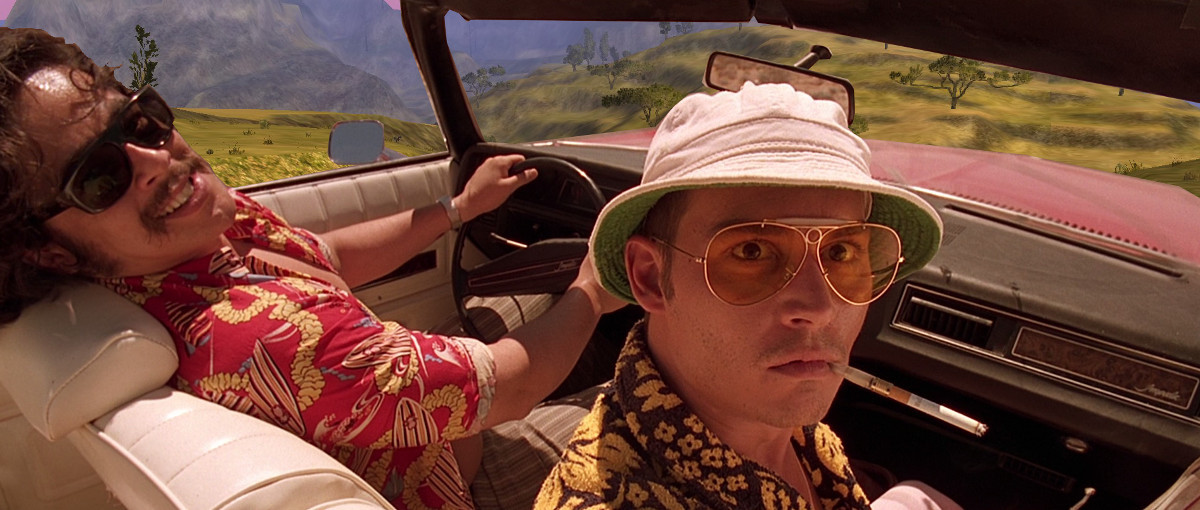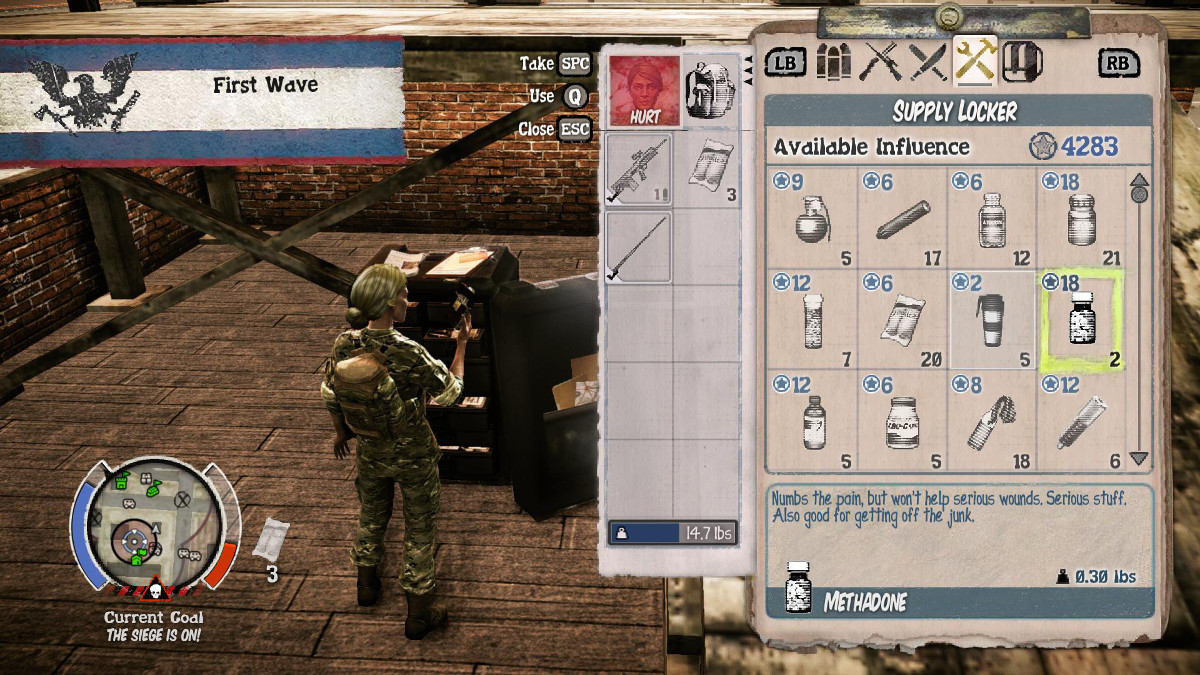We were somewhere around Ost Guruth on the edge of the Lone Lands when the Longbottom Leaf began to take hold.

This might come as a bit of a shock to some of you, but "drug culture" generally annoys the hell out of me. As much as I am an favor of legalization and whatnot, I don't care to know when people "smoke weed everyday." And I generally disagree when told that I should be high when watching certain movies or listening to certain music - if the art is such that the audience is required to change its brain chemistry to truly appreciate it, that art is garbage.
If you really look close, there are an awful lot of references to real-world illicit drugs and drug culture in a lot of games. Some of it is sort of subtle allusion, sometimes it's hitting you in the face and making you see desert-bats.
It happens just as much in fantasy settings as it does in real-world-based settings. Any game that has a "shaman" class is essentially depicting the use of psychotropic substances to achieve magical effects. That's what shamanism is - the shaman consumes a blend of herbs and plants and whatnot to achieve an "altered state of consciousness" so that he can commune with the spirit world. In other words, he gets high on peyote or mescaline or salvia or whatever bizzarro plants grow locally, trips out for a while and tells his tribes about the melting walls and being chased by purple snakes as though it were holy wisdom instead of a vivid drug trip. In video games, shamans tend to have mystical foresight, or divine healing powers, or supernatural spirit powers... but in reality, being a shaman is about getting high on psychedelic substances. He imagines he can talk to ghosts because he's tripping balls.

World of Warcraft kind of skirts the reality of psychedelic drug use by having its Shaman class be nothing like actual tribal shamans. WoW Shamans are based on the idea of communing with the classical elements rather than with spirits, and their talents are focused on fighting rather than being a tribal advisor. Which is kind of ironic, when you think about it. The cultures on which the three Horde races that could originally roll Shamans are based, all employ the drug-smoking, ghost-talking wise-man kind of shaman.
A lot of fantasy-type games rely on natural herbs for creating healing potions. There's nothing really wrong with this, as it has a basis in scientific fact. A lot of modern "wonder drugs" are derived from natural sources. Aspirin was derived from the pain-reliving chemicals in rosacea plants and willow bark, and penicillin comes from mold that grows on fruit and bread.
But a lot of modern "recreational" drugs are also derived from natural plants. When the Maester recommends "milk of the poppy" to relieve pain in A Song of Ice and Fire / Game of Thrones, he's not screwing around with willow bark or rosacea like some milquetoast wimp - he's recommending opium. That's some hardcore pain-killing right there. The sap from opium poppies is often processed into all kinds of fun drugs, from medicinal morphine to sweet, syrupy heroin. A drug, incidentally, first synthesized in a stable form by Felix Hoffmann at Bayer - the same guy who invented Aspirin. Truly the Walter White of his day.
Strangely, the effect that these all-natural-ingredient potions typically have is the healing of wounds. Aspirin and heroin do not, and were never intended to, actually close wounds and regenerate tissue. They dull the pain of wounds, but do not fix them up. This is why games like State of Decay are particularly funny - breaking into houses and stealing methadone is how a person survives zombie attacks, because in that game, methadone regenerates tissue and possibly prevents infection. There are a ton of awesome drugs in State of Decay, worthy of a Raoul Duke trip to Vegas with his lawyer. And they make an awesome Breaking Bad reference when detailing some of the stimulants your survivor group can make in its "Medical Lab."

The other effect home-brewed potions often have is restoring Power. Or Energy, or Mana, or Juju or whatever the game calls it - the other combat resource that isn't Hit Points. This is a lot more accurate in terms of what natural plant-based tinctures can do. Natural stimulants like caffeine and nicotine occur in a large number of common garden plants and herbs. Ephedrine, the chemical from which Walter White's baby-blue methamphetamine is derived, comes from a plant used in traditional Chinese medicine dating back thousands of years. So when your character is chugging that blue potion in the middle of a battle, remember that he's basically doing a big bump of crystal meth, like some skeevy tweaker at a rave.
I've recently been re-playing Fallout 3 and Fallout: New Vegas, and it's one of the most blatantly drug-filled games I think I've ever played. Stim-paks, which appear in the game as some kind of large hypodermic needle with a compressed-air delivery system, miraculously regenerate tissue. Can't really fault the game designers for that - basically every game that involves a character taking damage from enemies has a way to repair that damage, even though there's no real-world analogue that seals wounds and instantly regenerates damaged tissues.
You are also encouraged to use Med-X (which I translate as morphine or heroin, and which comes in the form of hypodermic needles) to reduce the amount of damage you take from enemies. You use another drug called Psycho (which comes in a cocktail-injection bundle, and may be based on a drug developed by the Nazis mixing cocaine, methamphetamine and oxycodone) to increase the damage you deal. Another drug, Jet (which comes in an inhaler, much like Benzedrine, which contained amphetamine), adds Action Points which are used during slow-motion combat to deliver precisely-aimed shots quickly. Fruit-flavored Mentats make the user alert and mentally focused, kinda like Adderall or cocaine.
That's really only the tip of the pharmacological iceberg in the Fallout universe. In New Vegas especially, there is a veritable cornucopia of awesome drugs that enhance your combat abilities. Some of them you brew yourself using irradiated desert plants and animal bits and whatnot. Most of them you loot from abandoned buildings, steal from occupied shelters, or loot from the bodies of your victims.
There is, however, a difference between the colorful drugs of the Fallout games and those of your average MMO - taking drugs in the Fallout games can have consequences. Your character can become addicted to pretty much any "chem" except Stim-paks, and addiction has negative effects on the character's stats.

The Fallout games also show a darker side of drug abuse - a lot of the inhabitants of the various post-nuke wasteland settings are addicted to something or other. The Jet addicts in the slums around New Vegas often mutter about eating rats and being in constant pain, and most of them have the look of pathetic victims of some horrible affliction. This is a vastly more realistic portrayal of drug use than the carefree quaffing of potion after potion in most fantasy-themed games.
To be honest, though, the most druggiest game I have played has to be the Lord of the Rings Online. On the surface, LotRO seems like a kind of gentle, innocent sort of game where you only play as the "good guys" fighting evil, and there are adorable little Hobbits running around giving presents to everybody every day.
Yeah. That's how they get you. The candy coating that makes the MDMA taste so sweet.
In many games - hell, let's say most - your "red bar" is "Hit Points," or the amount of physical damage the body can take before dying. Herbal remedies in those games fill that bar back up - in effect, regenerating tissue. In good ol' LotRO, the red bar is the character's "Morale" - his state of mind and willingness to continue the fight. When the red bar is depleted, the character is not dead, but rather too dismayed to continue fighting. Drinking potions brewed from Athelas leaves does not regenerate tissues, but rather improves the character's mood so he has more strength of resolve to continue fighting. In other words, the character is quaffing a mood-altering drug made from plants. One that makes him all fight-y. And then he bumps a rail of Celebrant speed to "restore his Power."
And that's just your "Health" and "Energy" potions. Of course, there are also the colorful curatives - yellow for disease, green for poison, red for wounds, purple for fear. I'm not too concerned about most of those. We can probably assume that the yellow potion contains some kind of penicillum mold, the green might be atropine or amyl nitrite or some other kind of specific anti-toxin, and the red contains a coagulant to stop bleeding. But what's that purple potion? It cures "fear" conditions - in other words, makes the character fearless. That's a sedative.
The drug references in LotRO go well beyond just combat consumables, however. One wouldn't consider alcohol to be a combat drug, but it's an in-game consumable. One with its own special screen effect when used in quantity. If you have ever wondered what the world would look like if you were Shane MacGowan, chug back a few pints at the Prancing Pony or the Green Dragon.

Now, this might seem harmless enough. But just about every festival - and there are several of those per year, like the Summer Festival happening now - Turbine rolls out the Inn League / Ale Association quests, which involve copious drinking and running from tavern to tavern in the Shire. And often, the only way to beat the timer is to ride your horse from one bar to the next. I'm not saying they're specifically promoting drunk driving, but they are at the very least turning a blind eye towards it.
If you binge-drink from one of the special kegs, which can be earned as housing decorations, there's an additional effect - the character drinks way too much, the screen goes all screwy, the character passes out and wakes up in some random place with no pants on. Often in some location that is not accessible by normal means, like the bar way up above the 21st Hall in Moria.
Speaking of Moria and crazy drug trips, the frogs in the Drowned Treasury epic book instance can have an interesting effect on the unwary. When they hit with their lick attack, the screen goes all drunk and pink for a few seconds. I imagine this is a nod to the cane toad, which secretes a psychoactive toxin from glands on its head, which has a psychedelic effect on humans. I haven't seen much about it lately, but kids used to lick cane toads to get high. Probably they still do, but I guess crystal meth is more popular these days.

And, of course, there's good old Hobbit pipeweed. That's a fairly significant thing in LotRO - a lot of resources have been devoted to its implementation. You can grow a number of different strains of pipeweed, and the really good quality stuff - the purple-named stuff, funny enough - is worth more than the common ditch-weed. You can cross-breed some types for rare hybrid strains. I don't see too many people growing or selling pipeweed these days on Arkenstone, but my Hunter has a few pouches of the good stuff stashed in his vault.
Fortunately, the game follows the lore of the books rather than the movies. In the books, Tolkien goes into more detail about blowing interesting smoke-rings, and the barrels of pipeweed that wash out of Isengard are proof that even the Hobbits in the Shire are no longer safe from the threat of great evil. In the movies, well... it's a little different.

No way in hell is Gandalf's "Old Toby" any kind of tobacco.
Got a favorite MMO drug-culture reference? Let us know in the comments!
To read the latest guides, news, and features you can visit our Lord of the Rings Online Game Page.


